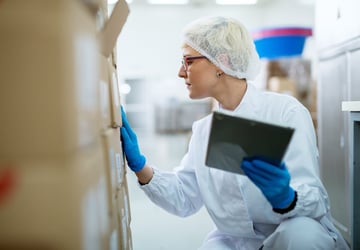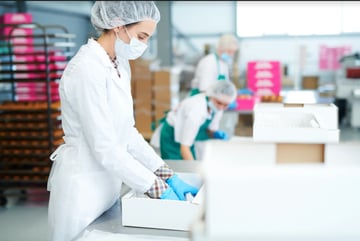As more is understood about the coronavirus disease (COVID-19) and transmission, food businesses that are critical to public function are creating new programs to enhance consumer and employee protections. Developing effective programs quickly ensures these manufacturing facilities and retailers are minimizing health risks related to the pandemic. Learn how FoodLogiQ customers are employing these strategies in our E-Book on coronavirus risk mitigation.
One of the most effective weapons against the novel coronavirus appears to be meticulous and regular sanitization and health protocols. During this crisis, it is paramount that facilities in operation understand how to enhance, pivot and deploy sanitization programs in immediate response to shifting guidelines. Execution of a successful new operational program requires seamless internal communication, and needs to be properly documented to ensure transparency and validity to any public-facing assurances.
Do You Need a New Sanitization Plan?
Unfortunately, there is no simple answer to this question - the current procedures, worker density, location and function of a facility are significant factors as to the form of any new sanitization program.
Some businesses' facilities have closed in the wake of stay at home orders issued to minimize the spread of the virus. However, many entities have been designated “essential” on the state and local level, remaining open even in areas with stringent lockdown measures in place. The FDA and the DHS have recommended food and agricultural workers be classified as essential during the COVID-19 pandemic. This includes industry workers in retail, grocery and food manufacturing. All U.S. businesses should coordinate regularly with local health officials on their status, as well as operational and sanitization guidelines. Find your local health department here.
Even if measures are taken to reduce person-to-person contact, essential businesses are running higher risks when serving necessary functions - and in some cases are operating at significantly higher capacity to keep up with demand. The FDA has indicated that businesses should use recommended cleaning materials for the virus: see the Disinfectants for Use Against SARS-CoV-2 list that have qualified under EPA’s emerging viral pathogen program.
While the FDA hasn’t mandated any new cleaning protocols specific to the COVID-19 crisis, food businesses are required to maintain compliant food safety plans under the Food Safety Modernization Act (FSMA). FDA Deputy Commissioner for Food Policy and Response Frank Yiannas issued a public statement reminding the industry that certain protections are always operant, regardless of the particular health risks:
Some protections live in the FSMA requirements that human food facilities have food safety plans to control risks associated with workers who are ill, regardless of the type of virus or bacteria. There are also requirements for human food facilities to maintain clean and sanitized facilities and food contact surfaces. Food-service workers also must continue to practice frequent hand washing and glove changes before and after preparing food. The animal food regulations also include requirements for cleanliness of the facility and personal cleanliness of employees.
Ensure your plan mitigates COVID-19 related health risks and is compliant with the FSMA Final Rule for Preventive Controls for Human Food.
What does a new sanitization program entail?
There are many new measures or enhancements food companies can implement to escalate their sanitization programs during the pandemic. It is worth noting that governmental guidelines may differ between your locations, so keeping impeccable documentation will be essential across your business - you may also consider implementing the most stringent requirements at all facilities during the crisis.
Before creating new policies it is important to 1) review and assess current procedures - if you don’t have a quick view into this, make sure it is well documented and stored going forward, 2) coordinate with all local health departments on essential business status and health recommendations, 3) develop new procedures informed by local guidelines, building off of your existing food safety plan 4) establish a training and communications plan, schedule and checklist to ensure policies are implemented and enforced and 5) document, monitor and iterate based on evolving guidelines or higher-risk areas of your plan. Maintaining visibility is a requirement for any effective food safety, health and sanitization plan.
Examples of health and safety procedures you may consider including in your plan:
- Escalating hand-washing requirements, training and sanitization signage
- Additional cleaning procedures and steps between customer check-out, opening, closing or manufacturing steps
- Relying on automatic entrances, exits and supplying sanitizer near high-risk surfaces like door handles
- Implementing the use of gloves for all employees, as well as masks where available and deemed appropriate by local officials
- Building new plexiglass protective shields for employees in high-risk areas
- Establishing roles and hiring personnel dedicated to cleaning and sanitizing
- Segmenting employee function and location to limit cross-functional or consumer exposure
- Establishing personnel and customer maximums for any room, building or facility
- Employee temperature checks
- Designing movement pathways for navigating a store or facility
- Creating line spacers to enforce 6-foot distancing guidelines for customers or employees
- Providing uniform cleaning within the facility to minimize contamination
- Creating a plan for a confirmed case of COVID-19 at any of your locations
- Generating a public communications plan to notify consumers of changes in procedures, operations and in-store policies
- Utilizing checklists and documentation of all cleaning procedures to identify potential risks, and to distribute to regulators and the public
Some of these items are covered in a checklist published by the FDA on Best Practices for Re-Opening Retail Food Establishments During the COVID-19 Pandemic. Any retail business that has experienced closures or limited hours should view the checklist prior to developing new sanitization plans for opening.
Implementing your new plan
Food businesses need to rely on strong operational infrastructure to adapt to the new normal. Typically, it can take weeks or months to deploy a new program across your locations. However, a rapid response sanitization program can save lives and keep your facilities compliant and running.
To prioritize employee and consumer safety, as well as maintain operations during COVID-19, many FoodLogiQ customers have successfully executed sanitization strategies and adapted their overall food safety plans. From documenting and tracking cleaning inspections to collecting required documentation and responding to virtual audits, FoodLogiQ customers are responding to, working with and safeguarding against supply chain disruption. Learn how many of them have been able to implement programs like these in our E-Book, 7 Ways FoodLogiQ Customers are Minimizing Risk During COVID-19.
If you don’t have a system that enables automated communication, checklists and centralized documentation, make sure you establish clear expectations around manual documentation and channels of communication. In addition, consider external resources that may be vital to your organization’s operations during this time. The FoodLogiQ team is working tirelessly to advance food safety and public health in this critical moment - reach out to our team if you’d like to learn about how our products can support your safety and transparency efforts.
Tag(s):
Other posts you might be interested in
View All Posts
6 min read
| May 13, 2020
Tailoring Document Requirements for Effective Risk Management
Read More
7 min read
| May 21, 2020
Conducting and Responding to Virtual Audits for Safe, Sanitary Operations
Read More
7 min read
| May 8, 2020

